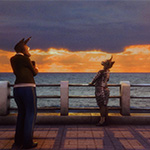For My Best Family, a new exhibition project conceived by artist Meriem Bennani and commissioned by Fondazione Prada, will be on view in its Milan venue from 31 October 2024 to 24 February 2025 (Press Preview on 30 October 2024). Meriem Bennani (Morocco, 1988) explores the potential of storytelling while amplifying reality through a strategy of magical realism and humor, juxtaposing and mixing the language of YouTube videos, reality TV, documentaries, phone footage, animation, and high-production aesthetics. Throughout her career, she has been developing a shape-shifting practice of films, sculptures and immersive installations, composed with a subtle agility to question our contemporary society and its fractured identities, gender issues, and ubiquitous dominance of digital technologies.
Bennani is developing a multi-sensory environment for Fondazione Prada. It will unfold in the two levels of the Podium, the main exhibition building of the Milan headquarters. Combining a new site-specific, large-scale installation with an art film co-directed with Orian Barki, For My Best Family explores ways of being together in public and intimate socio-political settings. This project is the most ambitious work Bennani has ever done both in terms of complexity, size and the length of the creative process, which took more than two years to complete.
On the ground floor, Sole crushing is a large mechanical installation that animates hundreds of flip-flops into a ballet-symphony-riot and musical composition. The soundtrack was composed in collaboration with music producer Cheb Runner. This kinetic and complex system is designed as an archipelago of polyphonic groups in which a multitude of flip-flops are arranged in different conformations: two “orchestras,” two spiral sculptures and a central island. Each item is connected to a pneumatic system that makes it mobile, alive, and breathing and to a drum surface made of various materials that amplify the sound of the object that hits it. This humorous and organic space will evoke states of collective catharsis, chaotic and organized collective rituals like Daqqa Marrakchia’s music performances in Morocco, architectures of spectacle like stadiums, states of delirium or hallucination, and protest.
Sole crushing can also be interpreted as a contemporary translation of the Duende, the collectively recognized yet inexplicable force embodied by Spanish flamenco, bullfights and ancient ballads on love and death. During a lecture poet Federico García Lorca gave in New York in 1929 on Andalusian music known as cante jondo , or deep voice, he used a quote by Johann Wolfgang von Goethe (“a mysterious force which everyone feels and which no philosophers has explained”) to define it. He considered the Duende intimately connected with “the hidden spirit of suffering Spain” and “a momentary burst of inspiration, the blush of all that is truly alive, all that the performer is creating at a certain moment.”
The first floor of the Podium will host a cinema-like space to screen For Aicha, a new art film directed by Orian Barki and Meriem Bennani under the creative production of John Michael Boling and Jason Coombs. Set between New York and Casablanca, in a world populated by anthropomorphic animals and suspended between realism, autobiography, and fiction, this artwork is the culmination of a long creative process that blends documentary and 3D animation languages.
The film and the installation are both aware of the history of animation cinema. Initially, cartoons expressed anti-realist and abstract forces, chaotic transgressions of narrative rules in images. Plasmatic entities that, according to film director Sergei Eisenstein’s definition, refused to assume a stable form, freed from anatomical limitations. In the 1930s, with the assimilation into the film industry, animated films’ characters took on more realistic anatomical forms, abandoning their archetypal role, in order to allow viewers to identify with these fantastical creatures. If the immersive installation refers to the early phase of animation when ordinary objects came to life, interacted, and responded to the environment, the surrealist film For Aicha fully expresses the narrative potential explored by animation in the second part of its history.
For Aicha follows Bouchra, a 35-year-old Moroccan jackal and filmmaker living in New York, as she writes an auto-biographical film exploring how her queerness has impacted her mother Aicha, a cardiologist jackal living in Casablanca. The story blends fiction —Bouchra’s film within the film— with an adaptation of recorded non-fiction conversations between Bennani and her mother. With tenderness and humor, both “filmmaker Bouchra” and “fictional Bouchra” seek to understand the nuances of their mother’s love and pain in order to move forward with their lives. The decision to use animated animals in this and previous works is a deliberate way of smuggling complicated messages in innocuous-seeming vessels. The narrative form of animation thus becomes a powerful device for addressing current and emerging topics in an inventive and intriguing form.
An illustrated book, designed by Tiffany Malakooti and published by Fondazione Prada, will accompany the exhibition “For My Best Family”. It will include an introduction by Miuccia Prada, President and Director of Fondazione Prada, a conversation with Meriem Bennani and Orian Barki by Niccolò Gravina and Mario Mainetti and a selection of essays and texts by American journalist and photographer Daniel Arnold, French-Tuareg researcher and philosopher Maïa Tellit Hawad, British-American art historian and curator Chrissie Iles, American urban and media historian Norman M. Klein, Canadian writer Emily LaBarge, Danish creative director and fashion historian Lars LaLa, and Moroccan writer Abdellah Taïa.
Press release from Fondazione Prada
Image: Orian Barki, Meriem Bennani, John Michael Boling and Jason Coombs. Still from For Aicha. 2024. Image courtesy of the artists



